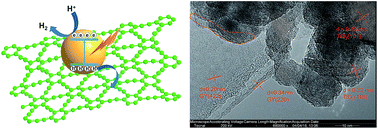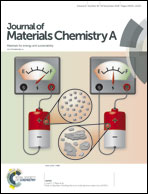Constructing a novel TiO2/γ-graphyne heterojunction for enhanced photocatalytic hydrogen evolution†
Abstract
The use of solar energy via photocatalytic hydrogen evolution is a promising means of energy conversion. γ-graphyne (γ-GY), a novel large π-conjugated carbon material, for the first time, is applied to construct a heterojunction with TiO2 nanoparticles for enhanced photocatalytic hydrogen evolution. The obtained TiO2/γ-GY photocatalysts were characterized by X-ray diffraction, energy dispersive X-ray spectroscopy, transmission electron microscopy, Raman spectroscopy, X-ray photoelectron spectroscopy, ultraviolet-visible (UV-vis) diffuse reflectance spectroscopy and photoluminescence spectroscopy, respectively. Enhanced photocatalytic properties were demonstrated for the as-prepared samples. The influence of the γ-graphyne content on the photocatalytic activity was investigated. The amount of hydrogen evolved from the optimized photocatalyst reached 77.6 μmol in 4 hours, which was about 8.4-fold higher than that of pristine TiO2. This is attributed to the TiO2/γ-GY heterojunction structure, which can simultaneously improve the absorption of visible light and suppress the recombination of photo-excited electron–hole pairs during the photocatalytic process. This work shows the potential of γ-graphyne for application in photocatalytic hydrogen evolution.



 Please wait while we load your content...
Please wait while we load your content...